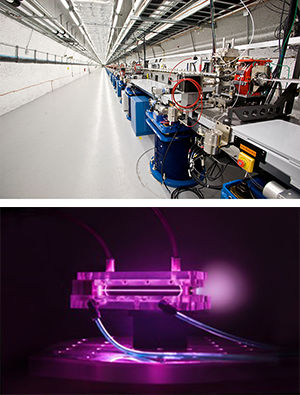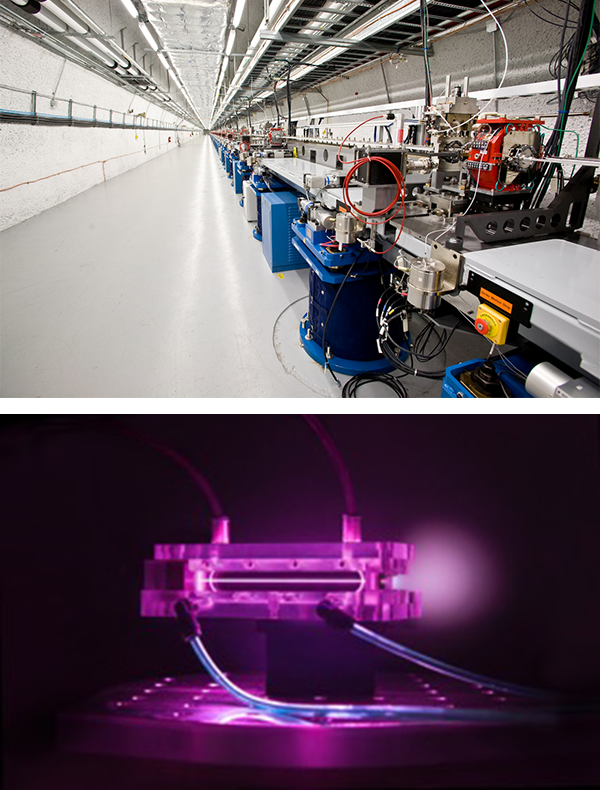X-Ray Lasers, Big and Small
Researchers hope that in a decade or so, x-ray sources will be able to emit pulses bright enough to image an individual protein in a single shot and short enough to “film” electrons moving in solids or molecules. To get to this point, x-ray free-electron lasers (XFELs) seem like the best bet: by feeding bunches of high-energy electrons into periodic magnetic structures called undulators, they can generate bright x-ray pulses a mere 30 femtoseconds long, and there is every expectation that 1-femtosecond pulses could soon be possible.
What will XFEL research look like 10 or 20 years from now? Will researchers flock to “big science” facilities like the current generation of kilometer-sized XFELs operating or planned around the world? Or will some disruptive technology emerge that allows XFELs to be built on a lab bench?
Physics paid a visit to two leading facilities—at very different stages of development—that are shaping the direction of XFEL science (see Fig. 1). At Stanford’s Linac Coherent Light Source (LCLS), the world’s most powerful XFEL, a segment of a 2-mile-long accelerator delivers electrons to a series of undulators, generating x-ray pulses a billion times brighter than conventional synchrotrons. On the other side of the San Francisco Bay Area, researchers at the Berkeley Lab Laser Accelerator (BELLA) hope to replace conventional accelerators with structures only a few centimeters long, using a technique called laser plasma acceleration.
Operational since 2009, LCLS has already started to tackle problems previously out of reach, in fields ranging from biology and chemistry to materials science and astrophysics. Biology stands to greatly benefit from the machine: one of LCLS’s dream experiments is to determine the structure of proteins without having to synthesize a large crystal of them. As a preliminary step, scientists have used the machine to tackle proteins that only form nanoscale crystals—too small for conventional synchrotrons. LCLS has also been used to make the first single-shot images of an individual virus.
LCLS has made fast progress. “After the invention of conventional accelerators, it took decades before they became the useful x-ray-sources we know today,” says Chi-Chang Kao, the director of LCLS. “LCLS has been able to pack the needed learning curve within the space of a few years.” Access to experimental time at LCLS is extremely competitive: only about 40 projects a year are awarded “beam time” out of hundreds of proposals. Kao believes that now the key to tap into LCLS’s full potential is to form a collaborative community of users.
BELLA’s research could contribute to widely available XFELs. As reported on December 8th in Physical Review Letters, researchers at BELLA have used plasma wakefield acceleration to kick electrons up to an energy of 4.2 giga-electron-volts—a new record for electrons accelerated in this way. In an accompanying Viewpoint, physicist Georg Korn explains the concept behind laser plasma acceleration and how the scheme might one day feed electrons into a tabletop XFEL.
Wim Leemans, director of BELLA, is optimistic about this possibility: “It’s realistic to expect that laser-plasma-acceleration XFELs could appear sometime in the next 10 years.” BELLA researchers are now testing how to feed their laser-accelerated electrons into undulators. (The currently used devices, donated by Boeing, are vestiges of the Reagan “Star Wars” missile-defense era.) To build a usable XFEL, they’ll first need to increase the stability of their lasers and plasmas in order to reproducibly generate perfect electron beams. They’ll also need to harness emerging laser technology to deliver more pulses per second.
What’s on the horizon for these two facilities? The next LCLS upgrade will deliver a million pulses per second (compared to the current 120) and improve the pulse “coherence,” an important step in acquiring images with finer spatial and temporal resolution. And the next version of BELLA, called k-BELLA (a play on the Italian expression for “what a beauty!”) will deliver electron bunches at a rate a thousand times higher than currently possible, a key requirement in XFELs for lab applications.
With a few other large-scale XFELs operating or planned in the US, Europe, and Asia, and a number of groups around the world improving laser-plasma-acceleration schemes, scientists might have two x-ray-laser options in a decade’s time: a state-of-the-art large-scale user facility delivering perfectly controlled x-ray pulses and a more customizable source, accessible at any time in their labs.
–Matteo Rini, Deputy Editor





